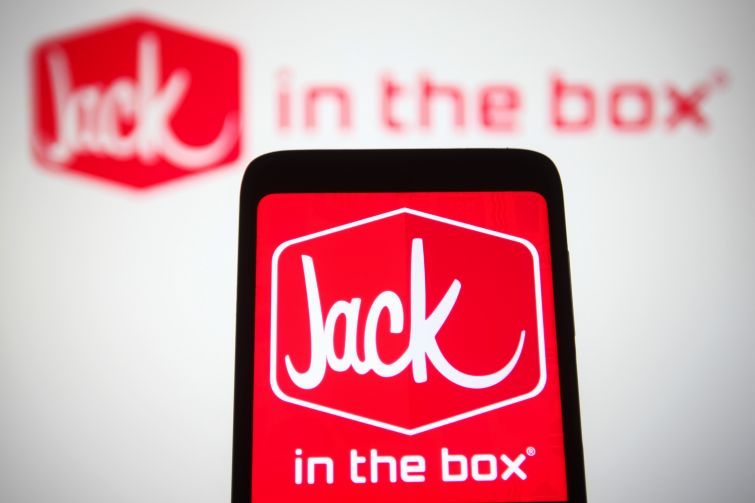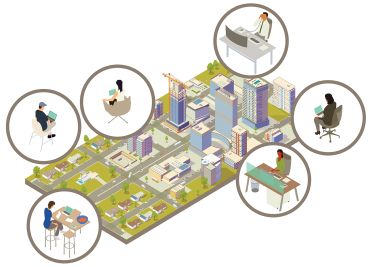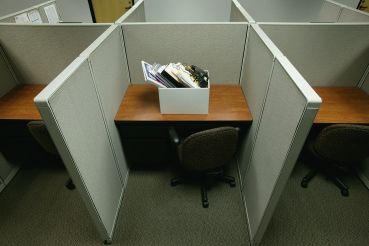Restaurants Put Proptech on the Menu
But there might be too many cooks in the kitchen sometimes
By Philip Russo April 16, 2024 9:00 am
reprints
Food for thought: While commercial real estate is replete with examples of proptech affecting malls, offices, stores and industrial niches like data centers, it’s probably affecting the restaurant industry more than all the others.
From Michelin-starred hot spots to name-brand franchises, restaurant investors, owners and customers are increasingly dependent on technology to improve and enhance their profitability and experience.
“I think restaurants are particularly, maybe even perennially, a seductive category for technology entrepreneurs because there are so many problems to be solved,” said Elizabeth Chrystal, a principal at Zigg Capital who focuses on the restaurant industry for the Manhattan-based proptech venture firm. “And it’s a business that many people love, either in experiencing restaurants or maybe starting their own restaurant. Yet it has such low margins that it feels like these problems should be very addressable by technology.”
Tight margins and a highly fragmented market have contributed to more than half of all restaurants failing within the first few years, said Chrystal. That reality has led many in the industry to attempt to improve the odds of success through technological innovation, often with mixed results.
“We’ve seen some really remarkable breakthroughs, with Toast, for example, with some robotics companies that are coming up, and with some innovative four-wall concepts that are thinking about growth in a new way,” she said. (Toast is a payment and service platform for restaurants founded in 2012.)
However, one aspect of the industry has not found technology leading to great success.
“I think with ghost kitchens, we are seeing the tide go out on some economic models that never really were the right side up,” Chrystal said. “And I think there is still a lot of value in a more old-fashioned commissary model where restaurants are centralizing their operations for off-premise dining.”
Ghost kitchens are usually defined as urban-located facilities designed for delivery platforms like Caviar, DoorDash and UberEATS, where customers are unclear whether they are ordering from a physical restaurant or a brand on a platform that may not be tied to a physical restaurant at all. The older commissary model involves restaurants centralizing parts of their operation. For instance, a bakery that bakes off site and then brings the product to its brick-and-mortar locations or to grocery stores.
For all their tech app capabilities, the problem with ghost kitchens is that they reduce the margins in an already low-margin business, ironically in part because they fail to eliminate middlemen.
“The average restaurant is generating around 15 percent profit, and that doesn’t leave a lot of space for someone else to cover their own costs and have everyone still making money,” Chrystal said, pointing to the delivery platforms themselves as well as the couriers and drivers who need to be compensated. “Perhaps ‘middlemen’ isn’t the right word, but there’s a lot of different parties involved trying to make a profit off what are usually less expensive meals than what someone is eating in a restaurant.”
Two proptech startups aimed at alleviating restaurant business pain points are Lightyear, an automated telecom procurement and management company, and Rainbow, which provides insurance underwriting for small businesses, including restaurants.
“Connectivity at the restaurant level is more important than ever, because there are more things in a restaurant that are connected to the internet,” said Dennis Thankachan, CEO and founder of Manhattan-based Lightyear, whose restaurant clients include the Five Guys burger chain. “One very simple example is point-of-sale systems, which are internet connected. You need that to process transactions. If you don’t have connectivity that is up and available, you can’t charge credit cards.
“Wi-Fi is an offering that now more and more restaurants want to be able to offer as an amenity. Also, there may be other machines or devices now in the restaurant that need to be connected to the internet. You add up all of these things and it means that the services that restaurants are purchasing, which used to be very baseline low-bandwidth connectivity, are now purchases of higher-bandwidth connectivity, and more focus on engineering.”
Lightyear was founded in 2019 as an office space connectivity company, but COVID-19 forced the company to pivot from that sector to retail, including restaurants, said Thankachan. Demand for Lightyear’s digital connectivity software has grown consistently since then, he added.
“We are the sole software product that digitizes all of this, and allows you to buy and manage this digitally, which saves a lot of time and money for the enterprise,” Thankachan said. “It’s more and more the case that if you’re operating a chain with a thousand locations, you actually need to have each store operating to a certain technical or engineering standard to be able to do things the way that corporate would like you to be able to do from an efficiency perspective.”
That means maintaining the same standards across a restaurant portfolio, even if that portfolio runs to the thousands. “And that’s very difficult to manage at a corporate level with maybe an IP team of five, 10 or 15 folks,” Thankachan said. “So we give you basically a software product that makes it easy for you to do that all centrally.”
Post-COVID, many name brand insurance companies abandoned small businesses, especially restaurants, as too large a risk, said Bobby Touran, CEO and co-founder of San Francisco-based Rainbow.
“Owners of small businesses and restaurants broadly defined are one of our verticals of specialization, and we are the insurance provider for restaurants in 15 different states, including here in California,” Touran said. “We focus on insuring the general liability and property risks of a restaurant, and they can basically absorb all those liabilities with a single insurance policy that we will sell them as a package.”
Rainbow is comfortable with the risks, because it specializes in the digitalizing for small business insurance risks, Touran said. “We do a number of different things from an underwriting perspective that we feel gives us the confidence to underwrite restaurants. One of the things that we do is we use the data that is available in the digital systems that restaurants use to get a clearer sense of the actual nature of the operations and the actual riskiness of the risk. We use third-party data to verify and augment the attributes of those risk parameters in order to be able to provide the most accurate price possible.”
Ronald Parker is chief operating officer of José Andrés Group and founder of Hospitality Multiple, an investment and networking platform for hospitality. Having also been CEO of Related Restaurant Group, and COO for Danny Meyer’s Union Square Hospitality, Parker brings a broad and long-term view of technology’s uses in the restaurant business — not all of it rosy.
“To be brutally candid, what I’m seeing is that there’s so many competing technologies — and I’m experiencing this right now with the José Andrés Group — we as an industry, I think have overcorrected with technology,” said Parker. “I’m finding most of my peer groups and people I’m talking to have so many layers of different technologies. And each technology has one or two components. A lot of them come in and they show you what looks like a Ferrari and the whole thing sounds amazing and great, but the ability to implement all of it — we all get excited and scream, and we think, ‘Hey, this is gonna solve everything.’ But we ultimately end up using first gear, second gear of that Ferrari, and you’re not even using the other gears. And then we start layering on other technologies. So, candidly, everybody is overcorrected.”
While some technology for the industry is great, the various software platforms don’t always talk to each other, Parker said. “It’s actually creating more complications in our industry. In the next few years, we’re going to go in reverse from technology. I don’t mean everybody’s going to abandon technology, but we will see people start to collapse the number of technologies they’re using, because as we’ve added more, it actually takes more time to manage. And we’re starting to realize as an industry that sometimes less is more of a technology.
“You need some technology, but we’ve all overcorrected, because everybody’s looking for the holy grail where they can manage their payroll and bookkeeping, their inventory and table management.”
Whether technology startups are saving restaurants money or are at least revenue neutral is a problematic question, Parker said.
“I’ll give you a great case in point. There’s Craftable, which a lot of people use in our industry, it’s like Restaurant365,” he said.
Craftable is used for managing inventory, invoicing and accounts payable — a back of house system, according to Parker. “The problem with that is all the chefs in each unit are entering recipes, creating this big recipe database. And, unless you have a control point, that gets out of control very quickly, because one chef in one restaurant might put an input for asparagus in the inventory system one way, while another shop and another unit might put the asparagus in a different way.
“So the issue with a lot of the software is, as they always say, garbage in, garbage out. The only way to accommodate that is you have to actually add corporate payroll to monitor and control a lot of these systems. So I’m an advocate of saying I actually think it costs us more. Technically, if the systems are working correctly, you should be saving money. I think the verdict is still out on that even though every software company will tell you they’re going to save you money. I’m still not convinced of it.”
However, table management and revenue management technologies such as OpenTable and Resy, are adding great value to the industry, Parker added. The problem, though, is they are competing rather than collaborating with each other.
“Restaurateurs are finding that you have to sign up through multiple table management systems and do manual entries to get as many guests as you can get, capture the funnel and bring them into your restaurant,” he said. “We all love the table management systems, because they provide self-support for a customer to make a reservation. That’s working well for our industry. Now, if they could just collaborate a little more.”
Also adding value are point-of-sale software systems that by their nature are a more collaborative part of restaurant technology, Parker said.
“They are doing a better job connecting [application interfaces] with a reservation management system. I can create a profile for you when you come into the management system and make a reservation through Opentable and actually track what your spend is and what your preferences are by connecting the two worlds between what you ordered and where you came into the system,” he said. “That’s really where a lot of the innovation has been happening and, if these companies continue to collaborate more, it would create a better guest experience.”
Philip Russo can be reached at prusso@commercialobserver.com.


